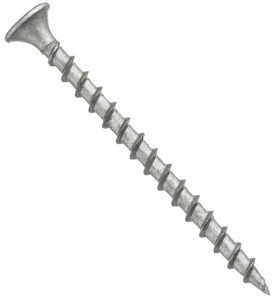
When shopping for screws, you may come across combination-head screws. They feature a pointed tip and a threaded shank. When driven into an object, the threads or “flutes” will remove material, thereby creating a hole. Combination-head screws, however, are distinguished from other types of threads by their dual-drive head design.
The Basics of Combination-Head Screws
Combination-head screws are threaded fasteners with both a Phillips and slotted drive type. The drive type refers to the type of screwdriver or bit that a screwdriver supports. It’s typically determined by the head recess.
Most screws have a shallow indention or recess in the head. You can tighten, as well as loosen, screws by placing the appropriate tool in this recess and turning it. Turning the tool clockwise will tighten the screw by driving it into the adjacent object, whereas turning the tool counterclockwise will loosen the screw. Combination-head screws have a recess that supports both Phillips head and slotted screwdrivers.
In addition to Phillips and slotted, other common drive types for screws include the following:
- Square
- Double Square
- Hex (Allen)
- Spline
- Clutch
- Tri-wing
- Six-lob
- Tamper-resistant
Why Choose Combination-Head Screws
With their dual drive type, combination-head screws are convenient. You can install and remove them using either a Phillips head screwdriver or a slotted screwdriver. Standard screws, on the other hand, require a specific type of tool. If you don’t have this tool — or if you’ve misplaced it — you won’t be able to install or remove them.
Combination-head screws are better protected from stripped threads than other types of screws. Stripped threads are often the result of using too much torque. If you use too much force when installing a screw, you may inadvertently strip the threads. With combination-head screws, though, you can simply switch to the other drive type if this occurs. If you strip the threads with a slotted screwdriver, for instance, you can use a Phillips head screwdriver to grip the other, non-stripped threads.
Choosing a Combination-Head Screw
You should consider the gauge when choosing a combination-head screw. The gauge represents the screw’s diameter or thickness. The higher the gauge, the thicker the combination-head screw.
Not all combination-head screws are made of the same material. Some of them are made of aluminum or brass, whereas others are made of stainless steel or titanium. Think about the type of object with which you’ll use it, and choose a material that’s appropriate for it. Stainless steel, for example, is a popular screw material for use with wooden objects.
Something else to consider is whether you want a fully threaded or partially threaded combination-head screw. All screws, including combination-head, have a threaded shank. Some of them, however, only have a partially threaded shank. With a partially threaded shank, they provide more gripping power.



